
























 By Mike Festa, state Director aarP Massachusetts
By Mike Festa, state Director aarP Massachusetts

Social Security is your money — you earned it through a lifetime of hard work. And like most Americans, that money is needed to help cover living expenses and pay bills. Nearly one in five Massachusetts residents — 1.29 million people — receive Social Security benefits, and 38% percent of residents 65 and older rely on the program for at least half of their income.
Here are 5 things to know about Social Security:
1. When can I start collecting Social Security? You are eligible to receive Social Security as early as age 62. However, the longer you wait to start collecting after you become eligible (up until age 70), the larger your annual payments will be. For those who are eligible for survivor benefits or Social Security Disability Insurance (SSDI), you can start collecting earlier.
2. Can I collect Social Security while working? Yes, you can collect payments while working. In fact, 26% of Social Security recipients in 2023 are still working. But if you are below full retirement age (67) and earn more than a certain amount, your monthly payments will be temporarily reduced. Once you reach full retirement age, your payments will be increased to make up for any previous reduction in benefits caused by earning more than the limit.
3. How much will I receive each year from Social Security? Your Social Security income will be dependent on multiple factors, but the most important is your lifetime earnings from work. The Social Security Administration takes your 35 highest-earnings years, calculates an inflation-adjusted average, and plugs this information into a formula to find your “basic” benefit. How old you are when you claim Social Security will also impact the amount you receive. AARP’s Social Security Calculator can help you estimate how much you will receive.
4. What is the maximum Social Security payment I can receive each month?
In 2023, the highest monthly payment for Social Security is $3,627; however, the average retirement benefit is $1,833. To receive the maximum payment, your earnings must exceed the maximum taxable income for at least 35 working years, and you must be at full retirement age, which is age 67 for people born in 1960 or later.
5. How do I sign up for Social Security? You can apply for retirement, spousal, or disability benefits online at ssa.gov, by phone at 1-800-772-1213 or in person at your local Social Security office. Find the local office closest to you at ssa. gov/locator.
AARP knows that you work hard and pay into Social Security, so it’s only fair for you to expect to get the money you’ve earned. Social Security is your money, it shouldn’t be a piggy bank for politicians. If they don’t take action to protect and save Social Security in the next 10 years, your Social Security could be cut by 20 percent — an average of $4,000 a year. Questions about your Social Security? Go to aarp.org/YouEarnedIt to learn more.
LAWRENCE – Just over a century ago, as World War I was drawing to a close, one of the most acclaimed American composers and orchestra conductors was born in this mill city on the Merrimack River. Leonard Bernstein was the firstborn child of immigrant parents who had come to the United States from Ukraine.
The life and career of Bernstein, who died in 1990, has enjoyed a resurgence of popularity and attention recently, with the release in late 2023 of the film “Maestro.” The film focuses on his complex relationship with his wife, actress Felicia Montealegre, who tolerated his substance abuse and numerous affairs with men throughout their 26-year marriage, until her death from cancer in 1978.
A talented piano player from childhood, he attended the prestigious Boston Latin School after the family moved to the state’s capital city, and they later lived in the nearby city of Newton. Bernstein attended and graduated from Harvard University, where


Acclaimed composer, conductor and Massachusetts native Leonard Bernstein was born in Lawrence, and also later lived in Boston and Newton.
(Photo/Wikimedia Commons/Allan Warren)
he studied music. After continuing his studies at the Curtis Institute of Music in Philadelphia and at Tanglewood in the Berkshires, Bernstein rose to prominence in the New York City music world.
Now streaming on Netflix, the movie “Maestro” focuses on composer and conductor Leonard Bernstein’s complex relationship with his wife, actress Felicia Montealegre.
He conducted the New York Philharmonic for the first time in 1943 at only 25 years old, after he was asked to fill in for the guest conductor who had fallen ill. Bernstein then achieved
fame literally overnight. The concert was broadcast live on the radio, and the next day he was prominently featured in newspapers across the country, including on the front page of the New York Times.
He would later become the music director of the New York Philharmonic for over a decade, teach and conduct around the world to great acclaim, and also composed numerous classical pieces and musicals, including one of the most enduring Broadway productions, “West Side Story.”
Now streaming
“Maestro” has been critically acclaimed and has won a number of awards. The role of Leonard Bernstein was played by actor Bradley Cooper, who also directed the film. It had its debut at the Venice Film Festival last September and then was featured at several other film festivals before a limited theatrical release in November. It is currently streaming on Netflix.
From Lawrence to Boston, Newton to Harvard and Tanglewood, Leonard Bernstein, despite living most of his adult life in New York City and Connecticut, remains an indelible presence in Massachusetts history.
• We are very experienced licensed audiologists who have been in business for 37 years. We actually care about you hearing better.
• Before you purchase hearing aids online, over the counter, from a big box store, or a TV ad, give us a call and make an appointment for a CONSULTATION.
• You may just discover you can get hearing care, AND hearing aids from LOCAL professionals for reasonable or the same pricing
• Give us a call at one of our three locations before you commit.

REGION – One of folk singer Greg Greenway’s most well-known songs is “Massachusetts,” an ode to driving in his adopted state, from his debut album, “A Road Worth Walking Down.” An audience favorite when he performs live, the lyrics tackle everything from rotaries to huge potholes and insults from other drivers with his tongue firmly in his cheek.
In the 40 years that have passed since the album was released, Greenway (http://greggreenway.com) has driven and walked many miles from the rural routes of his native Virginia to the rotaries of Massachusetts to the taxi lanes in front of Carnegie Hall to the roundabouts of Europe and far beyond.
Throughout his travels, he has maintained the proud tradition of not just folk, but gospel, rock, blues, jazz,
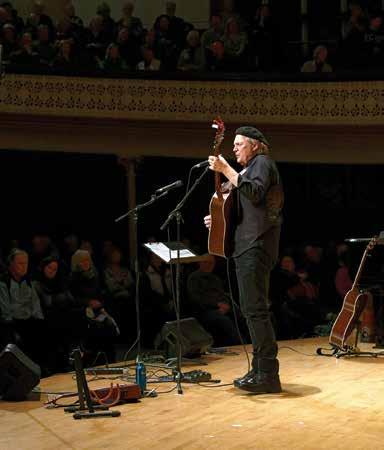
“Music has been my vehicle to see the world and to meet so many of the amazing people in it,” says folk singer Greg Greenway.
and world music in ways that have engaged new listeners while encouraging older fans to stay on the road with him.
And while the modes of transportation may have ranged from feet to cars to planes, Greenway sees the music itself as the means by which he has traveled the world.
“Music has been my vehicle to see the world and to meet so many of the amazing people in it,” he maintained. Greenway gratefully recalled the many times he has been privileged to play with his musical and personal heroes and to meet new ones.

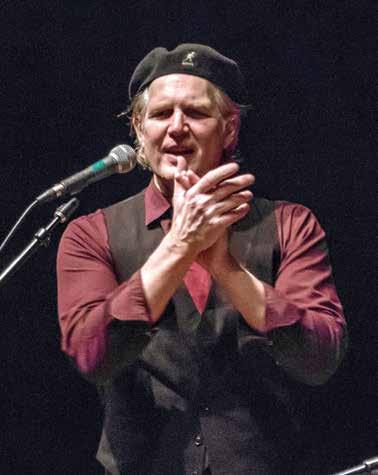
The youngest of three boys, Greenway was introduced to music by his family early on.
“He had a great voice,” Greenway recalled of his father who sang on the radio and in a gospel quartet. “Much better than mine…but it was my brother who played the saxophone in bands in high school who really got me started.”
Among the artists that Greenway’s brother introduced him to were Richie Havens and Eric Andersen.
“[They] can be heard in my guitar style even today,” Greenway explained, citing Havens’ famed percussive playing style and Andersen’s lyrical finger picking. “My whole life has been about combining those two styles.”
When his brothers had moved out, Greenway’s guitar “began to fill the space” and he eventually learned Bob Dylan’s debut album in its en-

Greg Greenway’s music encompasses not just folk, but gospel, rock, blues, jazz, and world music in ways that have engaged new listeners while encouraging older fans to stay on the road with him.
played a huge role in my development as I got my [education in music theory] through osmosis.”
Debuting at the Nameless Coffeehouse in Harvard Square, Greenway quickly found himself across the street at Club Passim and was soon taking his music all over the region and the world.
He took inspiration from his father’s gospel, his brothers’ pop music and the music of the civil rights movement that surrounded his adolescence. Greenway has not only expanded his musical repertoire but also his instrumentation, often playing piano, ukulele, and melodica in addition to his open-tuned guitar.
“Eclectic is the word that comes up most often in describing my music,” he admitted. “I tell you my story in my songs and, because of my beginnings in the Jim Crow South [and] the incredible journey of understanding that has been my musical career, they hopefully touch everyone.”
tirety by ear and began to perform in public.
“I played an Eric Andersen song in my senior year talent show,” he recalled.
During his college years, much of what was considered popular music consisted of works by singer-songwriters like Carol King, James Taylor, and Joni Mitchell.
“I soaked up every note,” he said. “I was hooked!”
With music as his “vehicle,” Greenway started walking down a road that led him to the booming singer-songwriter scene in Boston.
“I had the absolute luck to have moved in the center of three major music schools,” the former resident of Boston’s Fenway neighborhood recalled, citing Berklee College of Music, the New England Conservatory, and the Boston Conservatory. “That
And apparently they do. Greenway’s most recent CD, “Between Hello and Goodbye,” was number one on the folk charts last April and he was also the top artist with three songs in the top ten. As part of the musical collective Brother Sun (which also featured Pat Wictor and Joe Jencks), Greenway
produced two more chart-topping albums in 2013 and 2016. Most recently, he has reunited with long-time friend (they were born literally three days apart and have known each other for 30 years) Reggie Harris in a performance called “Deeper Than the Skin” (https://deeperthantheskin.com) that investigates the often-dissonant issues related to race in America.
“What I hope to do with my songs is what my heroes did for me,” Greenway suggested. “They liberated me with a passion for life and joy.”
As for those who ask what a live performance is typically like, the multi-talented multi-instrumentalist said, “I hopefully take you on an emotional ride of laughter, understanding, and passion.”
“My greatest hope is to empower people,” he added. “Everything begins with an idea and the energy to bring it into existence. Someone will make the future. Why not us?”
So the next time you find yourself stuck on a rotary (or anywhere in life), do what Greg Greenway often does— roll down the window and sing your passion.
Greenway will perform at the Homegrown Coffeehouse in Needham (https://uuneedham.org/events/ homegrown-coffeehouse/) on March 9 at 8:00 p.m.

MENDON – Author Michael Tougias is intrigued by stories of triumph. He interviewed over 100 people who survived harrowing experiences and shares their resiliency in his recent book, “Extreme Survival: Lessons from Those Who Have Triumphed Against All Odds.”
Harrowing ordeals
“I’ve spent over thirty years writing books about amazing stories of survival and my favorite part of the process was interviewing the survivors,” Tougias wrote in the book’s introduction. “I learned the details, not only of their harrowing ordeal, but also of how they eventually triumphed in face of overwhelming odds against them. They succeeded where the rest of us might think, I could never have made it.”
In this book, Tougias shares real-life situations. He instinctively coaxes the reader to think about what they would have done and how some of the survival strategies could be implemented in their own lives, depending on a given situation. Even though many of these survival stories are different, Tougias discovered that some of the techniques used were the same and those likenesses became the core of this book. He believes in the power of little steps.
“When I feel overwhelmed by a project, I break it down into smaller pieces. I focus solely on the chapter I’m writing,” he explained. “When I’m done with a chapter, I take a break. Extreme survivors taught me


that you can get overwhelmed when thinking about how much work you have in front of you, and that the best approach is to focus on just the next hour or two.”
At the end of each chapter, Tougias shares Survivor Lessons for Your Life, which are very thought provoking as well as motivating. One example is “If you think there is no aspect of your situation that is in your control, think again. You always have control over one factor: your reaction.”
Multiple best sellers
He often writes about adventure and travel and has written and coauthored over 30 books, some for adults and others for the Young Adult market. His best sellers include “The Finest Hours,” also made into Disney Motion Pictures’ movie version in 2016, “Fatal Forecast,” “Overboard,” “King Phillip’s War,” “There’s A Porcupine in My Outhouse: The Vermont Misadventures of a Mountain Man Wannabe” and more.
Tougias has quite a rigorous speaking schedule and encourages the public to attend. His speaking engagements have included the Maine Maritime Museum, North Platte, Nebraska Lecture Series, Survival Lessons Program, the U.S. Coast Guard in Tampa, Florida among many others. He has also been featured on television on “Chronicle,” “Fox and Friends,” and The Travel Channel, as well as National Public Radio and has made numerous business and college presentations.
He and Adam Gamble recently co-authored a book titled, “The Power of Positive Fishing” that depicts a 25-year friendship developed at sea and the
• Contemporary styled 1 & 2 bedroom apartments
• New kitchens with built-in microwaves and granite-like countertops
• Small pets welcome
• Heat and Hot water included
• Bus route / ample parking
• Beautiful landscaped grounds with gazebo





The most recent book by author Michael Tougias involved interviewing over 100 people who survived harrowing experiences.
power of male friendship through difficult times.
“One friend can make a huge difference in a person’s life. Everyone needs a friend with whom they can be themselves with,” said Tougias.
Love for the outdoors
Tougias does not like to take himself too seriously and considers himself to be low maintenance. His love of the outdoors is reflected in his writing and in his free time he will often immerse
himself outdoors. Whitewater kayaking, biking and walking through the woods brings him peace.
At the age of 22, he purchased a rustic cabin on a lake in Northern Vermont. There is no plumbing except for an outhouse but he loves it. A lot of his writing is done there. He hopes to bring his nine-month-old granddaughter, Robin, there to create wonderful memories.
Tougias grew up in Longmeadow and divides his time now between Mendon and Florida. He has been writing now full time for over 20 years and could not be happier.
“While writing is challenging, I love the research. I can go three months without writing a word,” he noted. “I had three new books released, all written during the Covid lockdown, so I made good use of being isolated and my usual 80 presentations a year went down to zero, so I had time. ‘Abandon Ship’ is part of the two kids’ series I have, with nine books in total. One is called ‘True Rescue Series’ and the other is the ‘True Survival Series,” said Tougias.
There is no slowing down at the moment for the 68-year-old author. “There is no age discrimination in writing. I plan on doing this for a long time,” he said.
For more information about the author visit www.michaeltougias.com.
The Aging and Cognition Laboratory at Brandeis University, directed by Dr. Angela Gutchess, is looking for research participants for cognitive tasks of thinking and learning.
Ages 59-99
At least a tenth grade education and English fluency. Each study takes 1 to 4 hours to complete. Studies pay between $10-$25 an hour.
Please call 781-736-3283 or email aginglab@brandeis.edu http://www.brandeis.edu/ gutchess/

If you realize there is a higher power and guidance that comes from God, then it gives you a peaceful feeling that no material possession can provide.
It’s the assurance, down deep, that everything is going to be alright.

AFFORDABLE HOUSING
Bigelow Village – Rutland
RETIREMENT LIVING
Congregational Retirement –Melrose
REST HOMES
Goddard Homestead –Worcester
ASSISTED LIVING FACILITIES
Brookhaven Assisted Care –West Brookfield
Goddard Homestead –Worcester
Heywood Wakefield Commons –Gardner
SUBSIDIZED HOUSING
Colony Retirement – Worcester
Green Hill Towers – Worcester
Sherwood Village – Natick
Managing
Cindy
CAMBRIDGE – In their book “The Two Most Important Days: How to Find Your Purpose and Live a Happier, Healthier Life,” Dr. Sanjiv Chopra and Gina Vild provide wisdom and practical tools that can lead to greater daily joy and abundance.
How does one approach a life that gives joy? What simple steps can each of us take to achieve lasting happiness? It’s important to know that happiness is hard-wired in our DNA. Most of us yearn for it but sadly search in the wrong places.
Mark Twain’s suggestion
They based their thesis (and their title) on the suggestion by Mark Twain that, “the two most important days in your life are the day you are born and they day you find out why.” Vild and Chopra not only suggest why it is important to find your purpose in life but offer practical, re-


“The psychological, physical, and social benefits of being happy are well documented,” says
search-based advice as to how to go about doing so.
Chopra and Vild met at Harvard Medical School, where she was serving as an associate dean and the
❖
❖
❖
❖
❖
❖
❖
 Esq.
Esq.
school’s chief communication officer, and he as a professor of medicine and the faculty dean of continuing education. In addition to being colleagues, they found a common passion, the quest for happiness and life purpose.
A shared sensibility
“We shared a sensibility about many things,” Vild observed. “We often shared motivational quotations that prod positive behavior and had deep-dive discussions about life’s big questions.”
As they worked on their own book, Chopra and Vild also discovered they shared an interest in literature, including a common love for the Sufi poet Rumi and the psychologist Viktor Frankl, who wrote the iconic book “Man’s Search for Meaning” about his how it was possible to find happiness and joy in the aftermath of the Holocaust.
“We often talked about happiness and why some folks appeared more prone to being happy despite experiencing life’s turbulent waters,” Chopra explained.
As they began formulating their book, they learned more than 200,000 books had already been written on the topic of happiness. They chose a fresh approach by differentiating their book on the role of purpose as a pathway to happiness.
“We saw there was a gap in the literature, and that we could offer fresh and valuable advice on how one could be happier,” Vild suggested. “There were certainly a variety of books that identified the problem, but few that offered that magic sauce of both practical and inspirational advice on how one could boost their
We
often
talked about happiness and why some folks appeared more prone to being happy despite experiencing life’s turbulent waters.
Dr. Sanjiv Chopra
happiness quotient.”
“The Two Most Important Days” offers personal stories, practical science-based findings, philosophical wisdom, and poetry. It includes exercises and a form of workbook to guide the reader in a simple and meaningful way.
“The psychological, physical, and social benefits of being happy are well documented,” Chopra assured, citing his research and that of many of his esteemed colleagues. “Those who identify as being happy enjoy more satisfying relationships, have better cardiac health, sleep better, and research is even showing happiness may lead to greater longevity.”
Chopra and Vild distill their findings to what they call the four tenets of happiness: friends, forgiveness, serving others, and living with gratitude.
Practical advice
When asked for practical suggestions, they advise their readers to nurture a broad range of friendships, find reasons to celebrate life events big and small, release bitterness and anger, and, importantly, live with gratitude each and every day. One more powerful bit of advice: smile broadly and often.
On this front, the book presents research that shows children smile an average of 400 times a day, while adults typically smile about 20 times a day. As a result, adults have less dopamine in their system and so are less happy overall. Beyond this, smiling is infectious, and has an exponential effect of making others smile infusing the world with greater joy.
Vild and Chopra will discuss their research and writings at the Needham Free Public Library on Tuesday, March 27 at 7:30 p.m. To register, please visit https://needhamlibrary. org/events/.
SOMERVILLE – Many people know the story of the first telephone call, made by Alexander Graham Bell in 1876 to his assistant Thomas A. Watson in the next room. But far fewer know that the first residential telephone was installed in a house in Somerville, owned by the man who made the first commercial telephones.
The house at 1 Arlington Street was built in 1858 and is now listed on the U.S. National Register of Historic Places. It was owned by Charles Williams Jr. and was used by Alexander Graham Bell and Thomas A. Watson to set up the very first home telephone in 1877.
The first practical telephone line in the United States was installed between Williams’ house in Somerville and his factory on Court Street in Boston. The home is believed to be privately owned today.
Manufacturer of first telephones for Bell
Charles Williams Jr. was an electrical telegraph equipment manufacturer. His equipment was used to

transmit text messages electrically over wires as opposed to physically via some other means like a train, horse, or on foot. The most wellknown worker of his was Thomas A. Watson, the recipient of that first successful telephone call made by Bell.

the Bell Telephone Company. He built the phones in the early days of the Bell Telephone Company, manufacturing two different models. The first was a box telephone and the second was a hand telephone. The initial production order was for 25 box phones at $160 each and fifty hand telephones at $2.45 each.
Supposedly, Bell said, “Mr. Watson, come here. I want to see you.”
Alexander Graham Bell went on to start the Bell Telephone Company. Watson joined the company and worked there for several years. Williams had telephone number 1 and 2 of
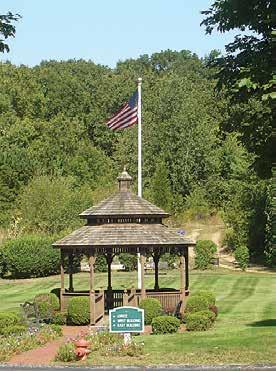

Customers would pay a monthly lease for two phones that were connected to a private electrical line between two locations, like a home to business, home to home, or business to business. Bell’s first paying cus-
Telephone | 13

SOMERVILLE – When they opened in 1969, John and Tina DeLellis probably had no idea how their little neighborhood bar, Johnny D’s, would become a crucial part of the lives of musicians far and wide. By the time their daughter Carla and son David had taken over, which followed the death of their father in 1984, Johnny D’s had expanded and included a stage for live bands and a fully operational kitchen. Closed since 2016, the venue served as a launching pad for country music stars the Dixie Chicks and 27-time Grammy winner Alison Krauss.
Perhaps more than that, it was like a second home for local talent and all genres of music from Afropop to blues to Cajun were welcomed. Artists from Cambridge’s Rounder Records label also performed there often. In-


terestingly, Rounder Records album covers were used as menus for a long time. There were even folks who said their wedding vows at Johnny D’s.
In 2016, owner Carla DeLellis told Boston Magazine, “I will miss this ex-
tension of my living room, where music fans, bar regulars, staff past and present, and restaurant customers gathered, and we were all able to share in conversations and experiences.” She jokingly added, “I will miss having


my dinner cooked for me, too.” Its jazz brunch was enormously popular and is still wistfully spoken about today.
Over its 47-year history the beloved club also offered the community a slate of events, including salsa night,


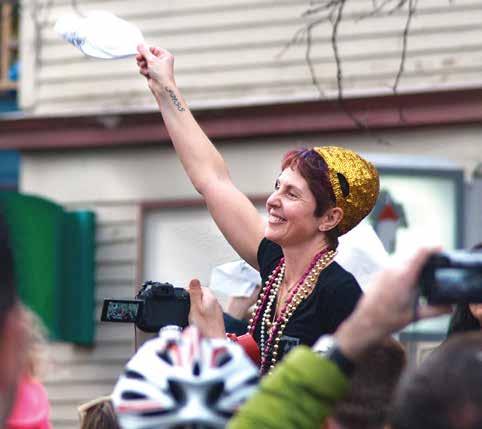
Johnny D’s served as a launching pad for country music stars the Dixie Chicks and 27-time Grammy winner Alison Krauss.
a Sunday night blues jam and a trivia night.
A place in the heart
Johnny D’s will forever hold a place in the hearts of many of its former regulars. “When I moved to Massachusetts as a ‘newly-single’ 30-something man in 1996, I put a personal ad in the now-defunct Boston Phoenix newspaper,” recalled Paul David Mena, who now lives on Cape Cod. “Following some less-than-stellar results, I cancelled my ad. Or at least I thought I did. In May of ‘97, I received an encouraging and very much unexpected response. After a brief email correspondence, we spoke via phone and decided to go on a date.”
“As I was living in Teele Square, I was familiar with Johnny D’s since it was across the street from the Davis Square T stop,” Mena explained. “My date Mary was familiar with Eddie Kirkland, a blues musician who would be performing there on the following Sunday, and the stage was set. I walked into a crowd of unfamiliar faces only to find that one of them was smiling at me from the other side of the bar area. That magical moment lives on over 26 years later.”
Mena’s wife Mary added, “After our first date there, we went back many times over the years to see lots
of live music: Bim Skala Bim, John Trudell, Johnny Hoy & The Bluefish, Treat Her Right, The Zambonis, The Baseball Project, and Sugar Ray and the Blue Tones, just to name a few. Paul and I have been married 25 years now.”
Final tribute
Son David DeLellis passed away in 1998. When family matriarch Tina died in 2008, the club’s stage briefly went dark in her honor, but the doors remained open for those who wanted to mourn the loss of the woman described as the pulse of Johnny D’s. Sarah Rodman composed a story about the matriarch’s legacy for the front page of The Boston Globe. Remembered for being brutally honest and known for having a hearty laugh, Tina mingled often before returning to “her seat” in the 300-person capacity room.
Carla DeLellis ran Johnny D’s for another eight years after her mother’s passing. When it closed in 2016, there was a show of appreciation from local musicians. They honored the club with a celebratory New Orleans-style funeral parade on March 13 through Davis Square, as a large crowd came out to bid farewell to Johnny D’s with an instrumental tribute that would make John, Tina, and David proud.
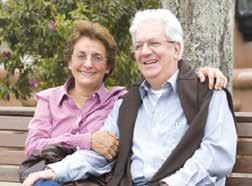
1. Is your Social Security and savings paying you enough each month?
2. Do you find yourself wishing you had a few more dollars?
3. Are you delaying retirement for fear of running out of money?
4. Are house repairs or improvements breaking the bank?
5. Do you wish you had a cash safety net if ever needed?
6. Are you curious about a reverse mortgage but someone said they’re “bad”?
If you are 62 years old or older and fortunate to own a home with some equity, then a government insured reverse mortgage may be the solution to a better life. This is especially true with the ongoing high cost of inflation.
A Reverse Mortgage gives a qualified borrower the option to receive tax free cash up front, or a monthly check, or a line of credit to access cash when desired with NO minimum or required monthly mortgage payment.* A reverse mortgage has no impact to Medicare or Social Security benefits. You still own your home and can prepay without penalty.
• Be able to afford your home
• Increase your monthly cash flow
• Pay off a current mortgage
• Pay off credit cards
• Access to tax free cash
• Complete needed home repairs
• Reserves for unforeseen emergency life events
• Estate planning to protect a surviving spouse
• Downsize and purchase a new home
• Peace of mind knowing that cash is available if needed
• And, the list goes on! What are your needs and desires?
*Note — You are required to pay ongoing real estate taxes ad property insurance and meet other loan guidelines.

Take Action!
A great place to start is get your free “How to Use Your Home to Stay at Home” 36page book. This is the official reverse mortgage consumer booklet approved by the U.S. Department of Housing & Urban Development and published by the National Council on Aging.
To receive your free copy, please call me at (781) 724-6221 or email at av@powhse.com
I am also available to evaluate your specific situation, answer your questions, and calculate how much money is available to you.
REGION – Associated Foot Specialists is ready to help.
The “full-service” practice provides numerous different services, including dealing with bunions, orthotics, warts, gout, ingrown toenails, flat feet, plantar fasciitis, and much more. Associated Foot Specialists’s experienced staff uses cutting-edge technology to treat patients of all ages.
“When people think of the podiatrist, they may typically think, ‘Well, I’m going to get my nails clipped,’ or ‘My grandmother is going to see the podiatrist.’ We take kids, we see adults, we see athletes, we see people who are ballerinas, we see soccer players… It’s a very important specialty, but not many people know exactly what we do,” Dr. Anthony Tickner, the founder of Associated Foot Specialists, told Fifty Plus Advocate.
Associated Foot Specialists also offers wound care treatment, which, according to the practice’s website, includes “innovative treatments and

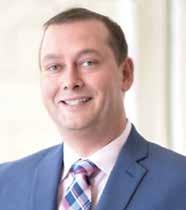
long-term strategies that help end the suffering of people with slow-healing wounds.”
Convenience is paramount to Tickner. While people may expect to wait weeks — even months — for care at other practices, Associated Foot Specialists seeks to help patients as soon as possible.
“Our motto is ‘We don’t want you waiting.’ That is a pet peeve of mine. If I have to see my primary [doctor] or the dentist and I’m the patient, I hate to hear ‘We’ll book you in three or four
months.’ That’s ridiculous,” said Tickner. “We pride ourselves on, if it’s an emergency, seeing them in a few days. We don’t like to have our patients wait. We’re able to get them in pretty quickly.”
Patients seem to appreciate Tickner’s dedication; based on 479 individual reviews, Associated Foot Specialists maintains an average rating of 4.95/5. One review calls the staff at the practice the “best [they’ve] met,” and another says that “this place deserves more than five stars.”
Associated Foot Specialists also promotes convenience with their multiple locations. With offices in Holden (795 Main Street), Worcester (1378 Main Street), and Hudson (1 Cabot Road, Suite 280), the practice ensures that patients throughout the Central Massachusetts area have easy access to care.
“We try to make it convenient geographically for our patients,” Tickner said.
With convenient, accessible care, Tickner hopes that patients will become comfortable around doctors, saying that he aims to “take the sterility and medical feel” out of appointments.
“It’s important that people feel comfortable and feel more like it’s family. Obviously, you’re going to a doctor — it’s obviously a visit. But, we want people to feel comfortable, we want them to feel at ease. I think that’s our mantra: we try to make people as comfortable as possible,” he said.
For more information on Associated Foot Specialists, please visit www. masspodiatrists.com

The first residential telephone was at this home in Somerville
tomer was a man named Roswell C. Downer, a friend of Williams.
Telephone | from page 9 them into books. She was hired by the ancestors of Charles Williams Jr. and along with fellow historian Stephanie Nichols, worked for two years putting this project together. They interviewed more than twenty family members and went through archives of old photos. The family members did not know much about him other than the fact that he had a lot to do with the telephone.
Charles Williams Jr.’s home later became known as the “Telephone House.” He was born on March 2, 1830, in Middlesex Village (now known as part of Lowell and Chelmsford) and was sixteen when he and his family moved to Somerville. He was the son of Charles Williams Sr., a hatmaker and Rebecca Frost Williams, and was one of five children. He died in Somerville on April 14, 1908, of bronchial pneumonia.
Somerville was a very different place in the 1800s as compared to the Somerville we know today. Many of those who resided there were involved in agriculture. A small number of men were doing business in Boston. Union Square had a half dozen homes and a couple of stores. The Middlesex Canal was in operation and Somerville had no sidewalks or streetlights, and no municipal water supply.
A subdued legacy
Chris Wisniewski, a historian, was invited to speak by the Somerville Historical Society in the fall of 2015. She helps families, businesses and non-profits preserve their stories. She takes personal photographs and turns

“Almost everyone knows the names Alexander Graham Bell and Thomas A. Watson connected with the early days of the telephone,” said Wisniewski. “But without Charles Williams Jr., Bell and Watson probably would not have achieved their success with their ideas as they did.”
There are a few references to Charles Williams Jr. in a publication called The Electrical Engineer. He is also associated with many patents; some of which were from his machinists and foremen.
It is a bit surprising that the name Charles Williams Jr. has not gotten the fame he deserves. He was instrumental in creating the early telephones and without his expertise, the ability to make a phone call and eventually connect with people all over the world might not have been a possibility at the time.



www.fiftyplusadvocate.com
If the only tool you have is a hammer, you tend to see every problem as a nail.
~ Abraham MaslowBy Marianne Delorey, Ph.D.
Ihavenoticed that after so many years in property management, my eyes are at tuned to what needs to be fixed. I can’t help myself, really. I walk into a new yoga studio, and I see water-stained ceiling tiles. I wonder where the leak was, if it is fixed, and if it resulted in mold growth.


In a lot of ways, it is not a pleasant default mindset to have — I am not always looking for problems, but I can’t help no ticing them. This way of viewing the world has made it difficult to visit friends’ houses without judgement or not express concern when it isn’t my place. One of the more interesting aspects of working with seniors is watching how each person adapts to aging. We acquire and develop new skills throughout our lives. Many of these tools can be carried forward into our later years in ways that help us age well. Some of these skills can be dysfunctional, either in most settings or they become more problematic as one ages. The trick for us all is to recognize in ourselves our primary tool sets and how to develop more as we age.
There are so many great skills that help us age. Empathy helps us adapt to apartment living by being compassionate about our neighbor’s limitations. Perseverance will keep people independent longer.
Some tools are more problematic. Some people find they can get more attention from their families if they create drama or act more needy or dependent.
Most behaviors and skills fall somewhere in the middle. It is in this vast gray area that us caregivers must wade through daily and find ways to lean on their existing skills to help them help themselves. I believe strongly that everyone’s biggest weakness is often also their biggest strength. By reframing learned behavior as an asset, we can help our elders find their own strengths. I have great sympathy for folks who have only been given one hammer. But the reality is, sometimes we have to make our own tools, and tweaking existing ones is the best place to start.
Teaching skills to older adults that help them age well is not impossible and sometimes caregivers need the skills to help people learn boundaries. The very first lesson to learn is that their preferred tool is not going to work. Sometimes this means not responding to angry outbursts or manipulative tactics. While these tools may have worked with family, caregivers need to have clear boundaries about what communication is acceptable.
Meet Cara. Cara’s always been pushy. She has been able to get what she wants from her daughters by demanding and pushing back. Several years ago, she had a major medical issue while out of state. All of a sudden, she learned that being transferred back to her home area was not an option, and she was not happy. But, she also needed to spend her energy getting better and staying positive. Once she was allowed to come home, she had a new appreciation for those around her and she was able to ask, instead of demand, what she wanted.
Cara and I have butted heads many times over the years, but we also respect each other. She has her opinions, but she is also capable of listening to ours. These skills have certainly been honed since she was sick. But she remains a tough person to please. Sometimes, we get it right. Sometimes, I feel like the nail.
Thismonth marks thirty years since I began writing a freelance column for a local weekly newspaper from my home in Marlboro.
Knowing that I’ve done anything for thirty years, and that I was a grown-up when I started, makes me wonder if I might be getting a little old. On the other hand, I’m still here, and the newspaper isn’t.

I’ve been writing happily for the Community Advocate family of papers since the spring of 2000.
Any community that still has a local newspaper, which I define as news-on-paper, is enormously lucky. Many don’t, as advertisers move toward online audiences and audiences
move toward online news sources. In many communities, there is no longer any source at all, on paper or on screen, for truly local news, like town government, non-profit activities, high school sports, marriages, births.
I may be hopelessly retrograde, but I love a news-on-paper. It has a such lovely soft feel and a distinctive inviting inky papery smell. If you see an article you want to save, tear it out. You can separate the sections, so you can share the paper with someone else. You can safely read it in the bathtub. If you spill coffee on it, it still works. No power outlet required, no battery, no internet connection or app or password.
And — this is huge — a newspaper on paper reflects, by placement and size of articles, the editorial judgement by staff members who give serious thought to what is important. A glance at a page reveals their assessment. By contrast, when you read news online, articles are most often in a scrollable row and all seem to carry equal weight. If we invade Canada — and if someone discovers a better way

to make a grilled cheese sandwich — these seem, visually, of equal importance.
My first real job was on a week ly newspaper in a suburb of Boston. That newspaper no longer exists except in the digital archives of the Boston Public Library. I was a student, and the lowest rung on the editorial ladder. I learned how to write everything from engagement announcements to obituaries to top-of-frontpage stories.
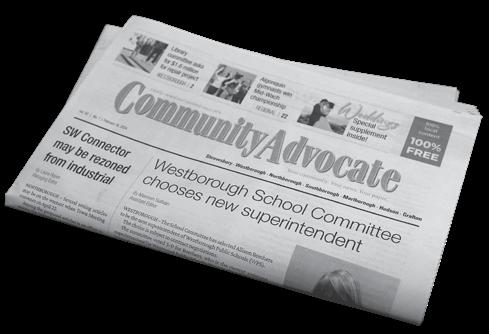
My words appeared in print! Sometimes I had a byline! There’s an old expression to describe writers who fall in love with seeing their words in print: you get printers’ ink in your veins. My veins filled up with printers’ ink.
And I learned to love newspapers.
Alas, much to my sorrow, and for the first time in my longish life, I can no longer get a big-city daily newspaper delivered to my house. I moved out of my Marlboro home, and now I’m on a country road where our nearest daily can’t afford to deliver. Since I want to
port regional journalism, I buy their digital version. I’m grateful for it, but I rarely look at it. It’s so difficult to navigate the pages on the screen of my little laptop. Besides, I like to read while I eat and I have learned, from sad experience, what happens when you spill drinking water on your laptop keyboard.
Our little community does still have a local weekly, printed on paper, so once a week we all enjoy the full newspaper experience while we learn what our select board is up to, what musical the local theater group is planning, who’s engaged.
All this is to say: If you feel as I do about news-on-paper, please support your local newspaper. If you don’t feel as I do, please support it anyway for the sake of your hopelessly retrograde relatives, friends, and neighbors.
Contact jlindsay@tidewater.net

SAUGUS – Once reported to be the highest-grossing and busiest restaurant in the entire country by Restaurants & Institutions magazine, the Hilltop Steak House was on top of its game when it came to low prices and large portions of food. For more than 50 years, the Hilltop had been able to draw customers from far and wide.
According to the late owner Frank Giuffrida, as many as 42,000 customers came through the doors in just one week in 1988. Located off bustling Route 1, the legendary steakhouse that opened in 1961 not only drew in locals but also drew the attention of travelers due to its reputation, outdoor decorations of plastic cows and the famous 68-foot-high neon cactus. Moreover, western-themed dining rooms were given names like Carson City, Dodge City, Kansas City, Santa Fe, Sioux City and Virginia City.
The Hilltop was so popular that Giuffrida was featured in the same May 1988 issue of People magazine where newlyweds Burt Reynolds and Loni Anderson graced the cover with their wedding photo.
During its heyday, the restaurant was able to serve up to 6,500 pounds of meat per day, thanks to its separate butcher shop which was just as popular as the main dining area. Although reservations and credit cards were not accepted until the 1990s and throngs of hungry customers did not mind the long wait, the restaurant stayed one of the busiest in America for over three decades. At one point, Hilltop served three times the volume of the nation’s second-largest restaurant, Manhattan’s Tavern on the Green.
Regulars recount memories
Nancy Tataronis wrote on the Lynn and North Shore History Group Face-

book page: “Hilltop was my father’s favorite restaurant. I remember waiting in line to get in and when we reached the huge steers, knew we were almost there.”
Karen Mersicano added: “Good old days for sure, worked there for 25 years.”
Amanda Kohut wrote: “I loved this place—went every year on my birthday and would joke about stealing the banjo off the wall…my best friend went to the auction after they closed and surprised me with the banjo and some other items for my birthday! Used to go with my nana and great nana when I was little…a lot of memories…I really miss that place.”
Gone but not forgotten
Hundreds of people lined up for one last meal before Hilltop closed its doors forever in October 2013. Soon afterwards, items from plates to menus from the restaurant were found on



and busiest restaurant in the entire country during its heyday. (Photo/John Margolies/Library
eBay after the owners claimed customers were stealing them to sell as memorabilia. Large items were eventually sold at auction and the Hilltop Butcher Shop, which had moved to Weymouth
in 2007, closed in 2015.
When asked which eating establishments do they miss in the Bay State, quite a few locals and visitors will have Hilltop Steak House on the top of their list. They would reminisce over the 18-ounce sirloins, filet mignons, tenderloins, iceberg salads and other dishes. Not many places are equipped to accommodate nearly 1,500 customers nor have a parking lot that allows space for nearly that number of vehicles. It was a one-of-a-kind restaurant and beloved tourist attraction.
The kitschy mega-restaurant perched atop a hilltop began as a career dream while Frank Giuffrida was on a European honeymoon with his bride Irene in 1961. Although it would take years before his full vision would come to pass and despite warnings from an uncle about opening a restaurant on Route 1 due to the surrounding seedy motels and bars, the Hilltop Steak House obtained great success.
Lisa Trapasso, a friend of one of Giuffrida’s daughters, Tina Giuffrida Primavera, wrote in a school project about Hilltop in 1990, “He had meat in his veins.” And judging from Frank Giuffrida’s decades-long success, perhaps he did.

IPSWICH – There’s something captivating and mysterious about wolves. Although long maligned in the public imagination due to unfair portrayals as vicious, bloodthirsty predators, today tourists flock to places like Yellowstone National Park for the chance to glimpse wolves in the wild.
Changing perceptions
Wolf Hollow, a nonprofit wolf sanctuary in Ipswich run by facility director Zee Soffron, aims to change people’s perception of wolves through education, advocacy and exposure. It helps to dispel myths surrounding wolves and remove the stigma associated with them. “It’s our belief that when people come and see this animal firsthand, it’s going to leave an impression on them,” stated Soffron. “We want people to leave here knowing at least one more thing than they came with. Whether they’re a novice and know nothing or

they know a few things about wolves.” Zee’s father Paul Soffron founded Wolf Hollow, which achieved nonprofit status in 1988. It opened as a wolf

sanctuary in 1990, when it brought in its first family of wolves. The first pup, Alyki, was born at Wolf Hollow in 1992. By 1995 Wolf Hollow had become an
established educational conservation organization for wolves. They constructed a public viewing pavilion of the wolves in 1999.
Wolf Hollow currently features eight animals: seven pure wolves and one wolf-dog hybrid, ranging in age from two to 12. The oldest, Linnea, who will turn 13 in April, is the last surviving sibling of a litter of five introduced to the facility in 2011. They have three juveniles: Vilkas, Togo and Skadi, all turning two this spring. Siblings Akela, Qantaqa and Skully will be six this spring. Gaia is the wolf-dog hybrid. The property spans five acres and features a 23,000 square-foot main enclosure. They also have four auxiliary enclosures, ranging from 5,000-7,000 square feet, if they must separate individual wolves. The typical life span of a wolf in the wild is 13 years, but in captivity, they may live up to 16 years or more.
Wolf Hollow is purely educational, and wolves raised in the sanctuary live their entire lives there. They are all born in captivity, and pups are in

First step. First word. First hug. First dance. Every first matters, and each milestone is worth celebrating, which is why we are proud to Go Red for Women. Find your first with us for a better stroke recovery.
more at ehc.rehab/fwn21

troduced to humans at approximately two weeks old when their eyes first open. “This is important as they come to see us as a trusted caregiver,” elaborated Soffron.
Hunted to extinction in New England
Wolves were one of the first animals that early settlers encountered, and those initial confrontations devastated the wild population. “Sadly, Massachusetts was literally the first place that there was an official hunting program on wolves,” explained Soffron. “In as early as 1630, the Massachusetts Bay Colony had an official bounty encouraging settlers to kill as many wolves as they could.” While claims differ on the exact date of their extinction, it’s believed they were largely exterminated from New England by the late 1700s.
For skeptics who might question the significance of protecting wolves in the wild, Soffron offered multiple reasons. One is that they benefit human hunters. Wolves are skilled at targeting weak and sick prey that has been compromised, and in doing so, contribute
to natural selection. They take the animals that hunters wouldn’t want, and for ethical hunters who relish a challenge, wolves “are keeping those animals smarter,” he related.
Considered a “keystone species,” wolves contribute to biodiversity and balanced ecosystems in big ways. When they were eradicated from Yellowstone in 1926, the park saw an overpopulation of herbivores like elk and mule deer. With no wolves to keep them moving throughout the park, they remained in one location and over browsed, eating vegetation down to the roots and denuding the landscape, including riparian buffers. When wolves were reintroduced, herbivores could no longer linger, and ultimately the root systems grew back stronger, the riverbanks were reinforced and river systems improved. “Really, they’re contributing to a healthier landscape overall,” asserted Soffron.
Additionally, wolves provide for other predators, such as bears, coyotes and foxes, that will scavenge their kills. There’s also an economic advantage to having wolves. Wolf tourism has boosted Yellowstone visits, particularly in the winter months during down
times, bolstering towns neighboring the park, commented Soffron. One June 2022 economic study found that wolf watching generates $82 million annually on average for local economies in Greater Yellowstone.
Another fallacy surrounding wolves entails their ferocious reputation and penchant for attacking humans. Soffron cited the statistic that in the last 100 years in North America, there have been two documented human deaths caused by wild wolves. He characterized them as nurturing, amazing parents that typically mate for life. “Their willingness to accept puppies and take care of puppies— whether they are birth puppies or adopted puppies. They love raising pups.”
The best way the public can advocate for wolves, which face the dual threats of industrial ranching and big game hunting, is to be vocal and write to your elected officials supporting strong environmental protections and legislation like the Endangered Species Act said Soffron. As he noted, even though there are no wild wolves in Massachusetts, our senators vote on national policies affecting wolves. Soffron, who also works as a middle school teacher during the week, remarked that even those who can’t vote
such as students can start fundraisers for Wolf Hollow or educate fellow peers about wolves through presentations.
If you go
Open year-round for public viewing on Saturdays and Sundays, Wolf Hollow offers guided tours and an educational program, as well as more informal tours for smaller groups such as families with young children. During the week they give tours to school, civic, and church groups, etc.
Principally, Soffron said it’s important to show the public wolves for the advocacy and educational components. “I want them to see the importance of this amazing animal and the fact that they are not a threat to humans,” he emphasized. “But also that they are beneficial, not just to the environment, but in other ways as well.”
Perhaps there’s also something primal about wolves that hits on a more visceral level. “Even just looking a wolf in the eyes for the first time is really huge for people. I think for a lot of people, it brings them back, even if just for a moment, to something that is inside of all of us that we’ve long forgotten,” mused Soffron.
For more information visit wolfhollowipswich.org.



SHREWSBURY – Grafton’s Small Stones Festival of the Arts features a collection of local photography, and in 2021, the festival included one image of something any Central Massachusetts resident would immediately recognize: Old Stone Church in West Boylston.
In the image, the historic church — which sits on the edge of the Wachusett Reservoir — is captured after a fresh, powdery snowfall. The pinetree branches are dusted with snow, the reservoir is icy and a picture-perfect Christmas wreath is hung on the church’s wall. The iconic photo, called “Old Stone Church Christmas,” was captured by former longtime Shrewsbury resident David Long.
Since Long’s 2021 submission, he’s had several other iconic images featured at Small Stones, including three at this year’s festival, which was held from Jan. 27 to Feb. 4.
Long has been interested in photography since he can remember, and he purchased his first camera at 17. After taking photography courses throughout college, Long’s photography expertise came in handy in his

Worcester-based job, where he helped the company photograph certain products.
Long arrived in Shrewsbury in 1995, living in the community until he moved to Falmouth last May. The community was the ideal location for Long enjoyed going into Boston and loved the biking trails, farmstand options and landscape north of Inter-



state 290.
“Probably my favorite thing about Shrewsbury was just the sense of neighborhood and sense of community. It was a wonderful tight-knit town,” said Long. “It was an ideal place to raise a family and spend a lot of my life.”
While Long certainly cataloged Central Massachusetts during his
time in Shrewsbury, leading to images like “Old Stone Church Christmas,” he also has traveled around the world, photographing some of the world’s most beautiful landscapes. Long has focused on the Northeast — including photo albums from Boston, Southern Maine, New Hampshire and Vermont — but he has also ventured to the Western U.S., South America, Europe, Asia and other exotic destinations.
“Every landscape photographer would probably have Iceland in their top four or five. It’s really unparalleled in terms of scenic beauty. Every place is different. I’ve been to China and Vietnam. I did a lot more people photography in those locations, people within landscapes. Then, the West Coast of the U.S. with the national parks still are huge favorites,” he said.
However, his passion for photography — and his two other interests — really blossomed after retirement.
“When I retired, my three favorite things were I loved to travel, I loved to hike, and I loved to do photography. And they kind of all went hand in hand. I did a lot of traveling, both here in New England and around the U.S. and world. It was a great mix of being able to combine my love of travel and hiking while taking my camera with me,” Long said.
“You never meet a landscape photographer who is in a bad mood,” he said.


Long said that local art festivals — like Small Stones in Grafton — are “extremely important,” saying that “no matter if you’re an amateur, professional, however you describe yourself, you love to be able to show your work and have somebody critique it.”
More information on Long is available at https://davelongphoto. com/.
Long offers in-person, on-site workshops, photography ebooks and enjoys spreading his love of photography to others.

BOSTON – Arguably, childhood intellectual growth plays an important role in the effects of adulthood. The powers-that-be behind kiddie programs like “Sesame Street” and “The Electric Company” understood that. So did the creators of “Zoom,” which was not only a part of the experimentation in educational television but was also designed to help model interpersonal relationships. The diverse cast of kids shined a light on their unique personalities, backgrounds and abilities.
Filmed at television station WGBH’s studios in Boston, the series originally ran from 1972 to 1978 and was created almost entirely by children. Original Zoomer Nancy Walker told National Public Radio, “It was seven kids having fun and just being children,” adding that it “allowed us to be inquisitive.” As an adult, Walker continued with some acting and got into television production.
Known for their catchy songs, older Massachusetts residents may remember one where at the end of each episode, Zoomers belted out the zip code, “0-2-1-3-4.” During the second and third seasons, cast members introduced new cast members with a song (“How do ya do do-dee-do, how do ya do-dee-do-dee-do, how’s your sister, how’s your brother, how are you?”).
Those who grew up watching “Zoom” often share their fond memories on the Zoom PBS Kids TV Show Fans Facebook page.
Donna Swanson Murphy wrote: “I loved the Mad Tea Party skit. Those kids were pretty good!
I dug Nina and Joe the most.”

Jim Hunt wrote: “I have a few great memories of the show, but one of the coolest things I recall is a kid who built this amazing treehouse that he had electricity in, he cooked something and played “Summer Breeze” by Seals & Croft on his radio at the end. There were some inventive kids back then.”
Another person commented on YouTube: “Such wholesome, entertaining, educational programming. I miss Zoom.”
Some viewers may recall segments like “Tracy Asks,” where young viewers were challenged by the host with questions like “Which came first, the chicken or the egg?” or “What is the world’s longest word?” Also, the recurring mock-soap opera during Season Four entitled “As the World Zooms.”
The remake
“Zoom” returned on PBS Kids, airing from 1999 to 2005. In the aftermath of 9/11, the series presented a special episode entitled “America’s Kids Respond.” In it, children from around the nation shared their feelings along with efforts in helping


Thursday,
Friday, June 28: $75 pp
Formal Dinner @ Venezias www.veneziaboston.com
Saturday, June 29: $20 pp
Cookout: Franklin Park from 11 am - 3 pm (near the tennis court)
Saturday Night Evening Activities from 8 pm - until Your choice of a night at Boston’s Encore Casino or Boston Bowl. You will pay as you go for either of these events.
The popular 1970s children’s television show “Zoom” was created almost entirely by kids at WBGH’s studios in Boston. (Photo/ courtesy of WGBH archives)
their communities in addressing the issues brought by the attacks.
Several kids volunteered with relief efforts by raising money, collecting, and donating food and clothing. Among the kids featured was a 12-year-old from Manhattan named Jemma, who baked cookies and delivered them to rescue workers. A group of students from Brooklyn who witnessed the attacks, created artwork

to give to their local firefighters and from Weston, a 12-year-old Muslim girl named Lana talked about the Koran and how it teaches not to kill.
There are former Zoomers who went on to careers which kept them behind or in front of the camera. Pablo Velez Jr., a “Zoom” cast member in 1997, starred in “The Three Stooges” (2012) and “Annabelle Hooper and the Ghosts of Nantucket” (2016).
Former Zoomer Joseph Shrand said the experience was “exhilarating” and “the best thing ever.” Now he is a psychiatrist and author.
“Zoom” creator and producer Christopher Sarson told NPR that after observing how his children behaved with peers they did not know, being eager to make friends but afraid of being laughed at, he set out to make a program that would deal “with personalities. And the interaction of people rather than with any particular storyline.”
“Zoom” was one of the most successful children’s programs of its day. Zoomers received over a million fan letters by its third season with some young viewers offering suggestions for themes, tongue twisters and riddles.





